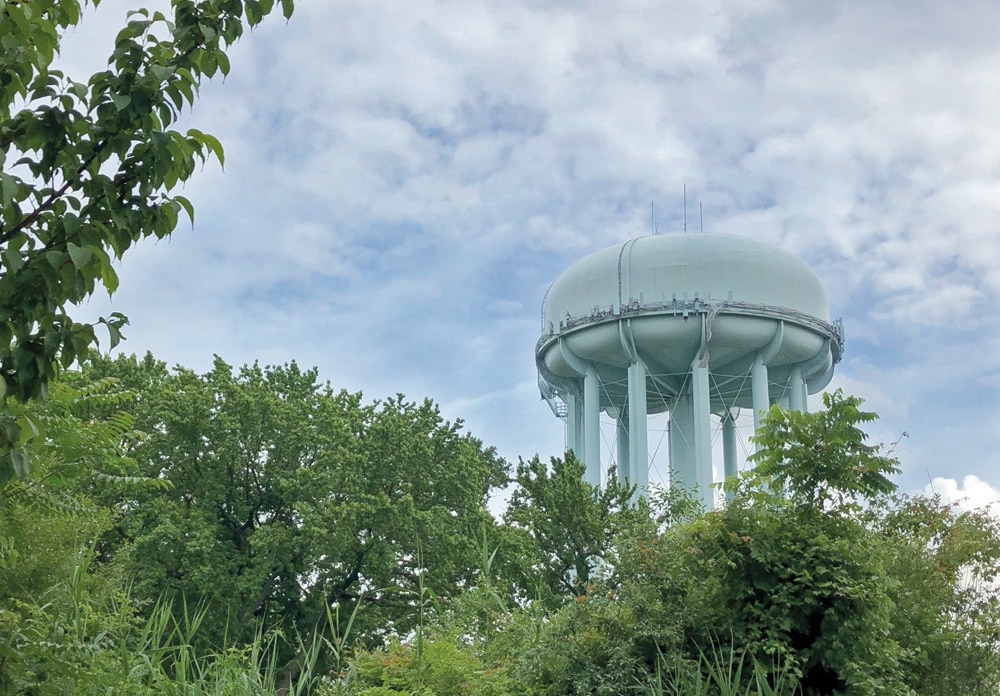Wading Through The Crosscurrents Of Long Island’s Drinking Water Contamination
In light of a recent report, this is the first of a three-part series on Long Island’s drinking water contamination. This section explains the risks of contaminants named in the report and explores how contaminants infiltrate our drinking water and bodies. The next two sections will detail public officials’ efforts to ensure Long Island’s drinking water quality and address how private citizens can protect themselves and fight for purer drinking water.

After reviewing federal data collected between 2013 and 2016, the New York Public Interest Research Group (NYPIRG) recently concluded that Long Island has, “by far,” more detections of emerging contaminants in its drinking water than any other region in the state. Released on May 28, the public education organization’s “What’s In My Water?” report named Nassau County as having the highest number of water systems in which emerging contaminants were uncovered.
Emerging contaminants, the report explains, are unregulated chemicals identified by the Environmental Protection Agency (EPA) as likely to surface in water supplies, bearing potential health risks. According to the report, 19 different emerging contaminants were spotted in Long Island’s water systems; seven were observed at levels above the EPA’s reference concentrations, which are non-enforced estimates of the maximum acceptable concentrations of toxic substances over a lifetime of exposure, based on health and risk assessments.
Although “reference concentrations are health-based,” an EPA web page cautions, “they do not represent regulatory values or action levels and should not be interpreted as an indication that the Agency intends to establish a future drinking water regulation.”
Emerging contaminants, often the carcinogenic ghosts of industrial processes past, can also be found in a variety of consumer products—from non-stick pans to baby shampoo to waterproof raincoats. The NYPIRG report urged the New York State Department of Health (DOH) to set Maximum Contaminant Levels (MCLs) for perfluorooctanoic acid (PFOA), perfluorooctanesulfonic acid (PFOS), and 1,4-dioxane in particular, which are currently unregulated in Long Island’s drinking water supplies. The report noted that though the “mere existence” of emerging contaminants “does not necessarily” endanger consumers, “their presence should spur a rapid science-based response by public officials.”
Anton Media Group spoke with several drinking water quality experts and public employees to make sense of the report’s findings and public health implications. From these interviews emerged crosscurrents of activists’ demands and perceived government inaction; of community safety and corporate gain; and of conventional medicine and intergenerational toxicity.
 How dangerous are the contaminants named in the report?
How dangerous are the contaminants named in the report?
PFOA and PFOS are two types of per- and polyfluoroalkyl (PFASs), a family of synthetic chemicals, a family of synthetic substances also known as “forever chemicals” because their strong carbon–fluorine bonds take millennia to disintegrate, making them particularly persistent in both the environment and our bodies.
As part of the federal Safe Drinking Water Act’s Unregulated Contaminant Monitoring Rule (UCMR), PFOA was detected at 48 parts per trillion (ppt) in the Town of Hempstead Water District. This level, “though 12 times higher than the 4 ppt recommended by advocacy organizations,” according to the report, is still 22 ppt lower than the EPA’s reference concentration of PFOA, 70 ppt.
According to an EPA web page, reference concentrations are neither “based on a level established as ‘significant’ or ‘harmful’” nor “representative of regulatory values or action levels.”
Yet in June, the nation’s top toxicologist suggested that the safety threshold for PFOA in drinking water ought to be a mere 0.1 ppt, or 700 times lower than the EPA’s current reference concentration. Dr. Linda Birnbaum, director of the National Institute for Environmental Health Sciences (NIEHS), cited recent research that links PFOA exposure to pancreatic cancer in rats.
Dr. Judith Schreiber—former chief scientist of environmental protection for the New York Attorney General’s Office—explained that toxicologists base risk assessment on the overall weight of hundreds of studies’ sometimes contradictory evidence before determining the highest appropriate amount of a substance. For 20 years at the DOH, Schreiber developed risk assessment practices; since retiring from public service, she now provides independent scientific consulting services at Schreiber Scientific, LLC.
Compared to other chemicals, Schreiber said, the deleterious health effects of PFOA and PFOS — effects on prenatal development and the immune system, ulcerative colitis, thyroid problems, preeclampsia and kidney and testicular cancer—are well-established at significantly low levels. Accordingly, she advised MCLs for PFOA and PFOS in the range of 4 to 10 ppt. The New York State Drinking Water Quality Council (DWQC), an independent entity tasked with helping the state assess emerging contaminants, proposed MCLs of 10 ppt in December. This recommendation is currently under consideration by New York State Health Commissioner Howard Zucker.
Schreiber warns that removing chemicals from drinking water supplies at such low levels isn’t easy; if taxpayers hope to lower their body burden of toxic chemicals, they should expect a monetary burden on their shoulders.
The Hicksville Water District (HWD) announced plans to install a pilot treatment system for 1,4-dioxane; according to a press release, however, the “process will be completed at no additional cost to Hicksville residents,” thanks to a $3-million grant from the state. The pilot testing system is being set up in coordination with the New York State Center for Clean Water Technology (CCWT) at Stony Brook University, following the discovery that the highest level of 1,4-dioxane detected in New York was 34 parts per billion (ppb) in the HWD—97 times higher than the EPA’s reference concentration of 0.35 ppb.
This reference concentration—nearly a third of the DWQC’s recommended MCL of 1 ppb for 1,4-dioxane—is not a health advisory level, but instead based on a one-in-a-million cancer risk. Under EPA’s terminology, up to 97 people “out of one million equally exposed people would contract cancer if exposed continuously (24 hours per day)” at HWD’s level of 1,4-dioxane “over 70 years (an assumed lifetime).” Due to its likely chronic effects on the kidney and liver, an EPA web page classifies 1,4-dioxane as a “probable human carcinogen.”
Dr. Arjun Venkatesan is the associate director for Drinking Water Initiatives at the CCWT. Whereas Schreiber mentioned that “every effort should be made to have low detection sensitivity” to measure emerging contaminants, Venkatesan highlighted the additional importance of risk assessment. Being able to measure a chemicals at low levels, he said, isn’t as meaningful without knowing how dangerous they are at those levels.
“One thing that we have to keep in mind is that the NYPIRG report shows detections of contaminants. The levels at which they are detected are more important,” he said. “You can tune your instrumentation to detect very low levels of contaminants… which is very good, but at the same time, we also need a more robust way of doing risk assessment.”
 How do chemicals infiltrate our drinking water and bodies?
How do chemicals infiltrate our drinking water and bodies?
Because of their resistance to heat, oil and water, PFAS quickly emerged as a moneymaker for numerous industries during the mid-20th century. PFOA and PFOS, part of that class of chemicals, are no longer synthesized in the U.S., according to the EPA, who in 2006 successfully invited eight major chemical manufacturers to eliminate their use of PFOA.
In a similar vein, Venkatesan said that the majority of 1,4-dioxane contamination “comes from the legacy of industry practices” 70 years ago, noting that the chemical’s stabilizing properties allowed it to become an industrial solvent in various manufacturing processes. 1,4-dioxane contamination can also come from consumer products, Venkatesan said, including shampoo, liquid dishwashing soap, and baby lotion.
Schreiber explored how past industrial processes continue to haunt our water and our bodies. PFOA and PFOS were heavily used in firefighting foam, she said, for decades without public knowledge of their environmental impact. She recounted how, because of runoff, the residue of firefighting foam—used for training purposes at fire departments, military bases, and airports—would permeate groundwater and seep into rivers and streams, their toxic materials spreading far and wide over time.
“That’s why they’re called ‘forever chemicals,’” she said. “Not quite forever, but for a long time… And there’s nothing much you can do about it, quite honestly.”
Industries have replaced PFOA and PFOS in firefighting foam, Schreiber continued, with other PFASs. In theory, Schreiber explained, these replacement chemicals should be less persistent because they have shorter carbon chains, to which fewer fluorines are attached. However, they haven’t been studied to nearly the same extent as PFOA and PFOS. The few that have been, she said, demonstrate similar potential health effects.
“Our federal chemical regulatory system is unable to fully evaluate existing chemicals for their toxicity and exposure concerns,” said Dr. Alissa Cordner, codirector of the PFAS Project Lab at Northeastern University.
Liza Moran, who cowrote the NYPIRG report and is the organization’s environmental policy director, agreed with Cordner, adding that though PFOA and PFOS have been phased out, there are little to no regulations that prevent their continued use. She also suspects that many fire departments, military bases, and airports improperly dispose of old firefighting foam, letting PFOA and PFOS reach more drinking water supplies.
“We need to stop using chemicals and products and manufacturing processes until they’re proven safe for public health,” Moran said.
Dr. Laura Rabinow, who was the New York State Senate Democratic Conference’s Environmental Conservation Policy Analyst in 2017, echoed Moran’s sentiments. She noted that of the more than 80,000 chemicals currently in manufacturer use in the U.S., most haven’t been tested for their human health effects. Only about 90, she said, have been regulated since the Safe Drinking Water Act was established in 1974.
“That is a very small number,” she said. “We need to shift the burden of proof onto companies to show that individual chemicals within a group may be safe or safer, as opposed to putting that burden on communities after the fact.”
Dr. Jaymie Meliker—an associate professor of Family, Population and Preventive Medicine at Stony Brook University who studies exposure-disease relationships—explained that testing for human health effects takes an “extraordinarily” long time, which he thinks is part of a “broader point” about why PFASs and 1,4-dioxane pollute our environment.
“This is the grand deal that we have made—not necessarily explicitly, but we’ve made it. We said, ‘You know what, give me my cell phone, give me my new technology… You don’t have to test for whether or not it’s going to cause me harm,’”’ he said. “So long as that’s the deal that we’ve made, there are always going to be emerging contaminants.”
PFOA and PFOS can also be found in a variety of consumer products, such as food packaging, stain repellents, and nonstick cooking pans.
“I probably have them in my raincoat; it’s waterproof,” Rabinow said. “A lot of folks have them in their shoes, if they’re made with Gore-Tex.”
Schreiber added that PFASs from fabric, furniture, and shoes can make their way into house dust, which can be inhaled or ingested by children, who “have a lot of hand-to-mouth activity and crawl around with wet, sticky hands.”
PFASs are also transmitted in utero from the placenta to the fetus. In addition, Schreiber said, because PFASs are both water- and fat-soluble, they can reach a person’s fats and blood supply, from which breast milk is produced.
“The mother’s breast milk will contain levels of these chemicals because of her prior exposures through her life,” Schreiber said. “There’s really no way to prevent it; that’s how it is.”
Because “very little” of PFASs gets excreted in urine or feces, Schreiber described breastfeeding as “the most effective body burden reduction.”
“I’ve done a lot of work on different chemicals in breast milk exposure, and it’s really emotional for women to realize that their bodies are contaminated,” she said. “Mothers want to do the best things for their babies.”
PFASs can also worm their way into cow’s milk—and meat—because of their presence in “sewage sludge” used as a soil conditioner, Schreiber said.
Cordner also discussed the role of sewage sludge, which the EPA defines as “the solids separated during the treatment of municipal wastewater.” In addition, she underscored how PFOA and PFOS have been able to flourish despite the chemical industry’s knowing about their toxicological concerns “as early as perhaps the 1960,” she claims.
“Why did it take so long for them to be removed from production?” she said. “Profit motive on the industry side combined with an insufficiently regulatory system.”
Read Part Two and Part Three.



















